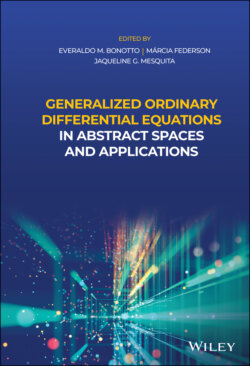Читать книгу Generalized Ordinary Differential Equations in Abstract Spaces and Applications - Группа авторов - Страница 21
Definition 1.42 (Indefinite Vector Integrals):
Оглавление1 Given and , we define the indefinite integral of with respect to byIf, in addition, , then
2 Given and , we define the indefinite integral of with respect to byIf, moreover, , then
Note that Definition 1.42 yields the inclusions
If in item (ii) of Definition 1.42, we consider the particular case, where , and for every , is the identity in , then instead of , , and , we write simply
respectively, where
If in item (i) of Definition 1.42, we have , then one can identify the isomorphic spaces and and, hence, the spaces , , , and can also be identified, because one has
Indeed. It is clear that In order to prove that , it is enough to write the usual Riemannian‐type sum as two sums (with the positive and negative parts of the sum):
for every ‐fine corresponding to a given .
As we already mentioned, we will consider a more general definition of the Kurzweil integral in Chapter 2. Thus, in the remaining of this chapter, we refer to the integrals
as Perron–Stieltjes integrals, where and .
As it should be expected, the above integrals are linear and additive over nonoverlapping intervals. These facts will be put aside for a while, because in Chapter 2 they will be proved for the more general form of the Kurzweil integral. In the meantime, we present a simple example of a function which is Riemann improper integrable (and, hence, also Perron integrable, due to Theorem 2.9), but it is not Lebesgue integrable (because it is not absolutely integrable).
Example 1.43: Let be given by , for , and , for some Then, it is not difficult to prove that exists, but , once
Another example is also needed at this point. Borrowed from [73, example 2.1], the example below exhibits a function (that is, belongs to , but not to ), satisfying . However, for almost every . Thus, such a function is also an element of (because it belongs to ) which does not belong to , showing that, in the infinite dimensional‐valued case, may be a proper subset of .
Example 1.44: Let be an arbitrary set and let be a normed space. A family of elements of is summable with sum (we write ), if for every , there is a finite subset such that for every finite subset with ,
Let denote the set of all families , , such that the family is summable, that is,
It is known that the expression defines an inner product and , equipped with the norm is a Hilbert space. As a consequence of the Basis Theorem, since is a Hilbert space, is a maximal orthonormal system for , that is, and stands for the Kronecker delta (see [128, Theorem 4.6], item 6, p. 61)).
In what follows, we will use the the Bessel equality given as
Let be a nondegenerate closed interval of and be equipped with the norm
Consider a function given by , . Given , there exists , with , such that for every ‐fine ,
where we applied the Bessel equality. Thus, and , since for every . On the other hand,
for every . Hence, .
